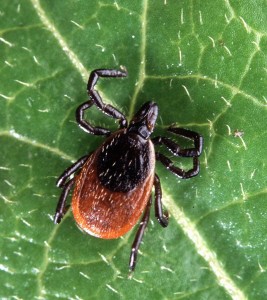26
Aug
CDC Study Finds Pesticide Ineffective at Stopping the Spread of Lyme Disease
(Beyond Pesticides, August 26, 2013) A recent study presented by the Centers for Disease Control and Prevention (CDC) at the International Conference on Lyme Borreliosis and other Tick-Borne Diseases in Boston finds that spraying lawns with the insecticide bifenthrin does not reduce the incidence of tick-borne diseases. The study could have important policy implications for towns and communities that are feeling pressure to spray as prevalence of tick-borne diseases, such as Lyme disease, continue to rise. There are least-toxic alternative management strategies that are effective and  safer than chemical controls.
safer than chemical controls.
The recently released study by CDC included 2,500 households in Fairfield, Litchfield, and New Haven Counties in Connecticut; Dutchess County in New York; and four counties in Maryland. Half of the households’ lawns were sprayed with bifenthrin and the other half was sprayed with water as a control. The study, conducted over two years, found that the households that were sprayed with bifentrhin saw a 60 percent reduction in ticks on their propriety but still had similar levels of tick encounters and tick-borne illnesses. These final results are similar to the results the study found after its first year. This research reveals that using pesticides is not an effective way to curb tick-borne disease and can leave families dealing with another medical issue: the negative health effects that can be brought on by the use toxic pesticides.
This study’s findings are also important because as tick-borne illness are increasing there will be greater pressure for communities to use toxic controls for ticks. A few days before CDC released its study on pesticides the CDC reported preliminary estimates indicating the number of Americans diagnosed with Lyme disease each year is around 300,000. The new estimate suggests that the total number of people diagnosed with Lyme disease is roughly 10 times higher than the yearly reported number to CDC. Lyme disease cases, which are caused by the bacterium Borrelia burgdorferi being transmitted to humans through the bite of infected ticks, are concentrated heavily in the Northeast and upper Midwest, with 96 percent of cases in 13 states. Paul Mead, M.D., M.P.H, chief of epidemiology and surveillance for CDC’s Lyme disease program, cautioned in a CDC press release, “This new preliminary estimate confirms that Lyme disease is a tremendous public health problem in the United States, and clearly highlights the urgent need for prevention.”
Beyond Pesticides was critical of CDC and the Maryland Department of Health and Mental Hygiene’s decision to enroll Maryland households into the recently released pesticide study in 2012 after its first year because of the lack of (i) public disclosure of the test pesticides’ potential health effects and (ii) attention to the efficacy of alternative management strategies. Beyond Pesticides maintains that it was wrong to put test families at risk of pesticide exposure, especially since the study found pesticides are ineffective in curbing tick-borne illnesses in its first year. Beyond Pesticides also found the information about the study posted on the CDC’s website misleading, as it did not fully inform participants of the hazards posed by bifenthrin. Beyond Pesticides spoke directly with state health officials in an effort to relate concerns about this study. “It’s improper to be conducting a human experiment like this,” said Jay Feldman, executive director of Beyond Pesticides.
Bifenthrin, the insecticide used in the recent CDC pesticide study, is identified as an endocrine disruptor by the European Union (May 2010), and is considered a possible carcinogen by the U.S Environmental Protection Agency (EPA). It is a pyrethroid class pesticide, a group of known neurotoxic chemicals. A recent study in the journal Environmental Health Perspectives (2007) of infants born to women with agricultural exposure shows a possible impact of bifenthrin on the occurrence of autism spectrum disorders. Bifenthrin is also toxic to birds, fish and bees.
Though toxic methods have been proven unsuccessful in stopping tick-borne illnesses, there are safe, non-toxic alternatives that are successful. In areas that are potential tick habitats, you should wear light-colored clothing that covers the body (especially your legs) because it makes it easier to spot ticks so they can be removed before they bite.
Another effective way to avoid ticks is to only use unscented deodorant, soap and shampoo. An exception is Packers Tar Soap, which has a natural pine scent which can keep ticks from biting once they have been picked up. Similarly, you can try using least-toxic herbal repellants such as oil of lemon eucalyptus and essential oils. Most importantly, after you have walked through high grass in a tick infested area, check the entire body for ticks and shower to wash off any ticks that have not yet become embedded.
If you do find an embedded tick, remove it carefully. Protect your hands with gloves or a tissue. Use blunt, curved tweezers, not your bare fingers, and exert pressure on the head of the tick and gently pulling the tick straight out very slowly. Do not twist and do not crush the tick. The body fluids can cause infection if exposed to even unbroken skin. Do not kill the tick while still embedded. Kill the tick in soapy water or alcohol, clean the wound with antiseptic, and monitor carefully for any signs of infection. If you observe symptoms of Lyme disease such as a bull’s-eye rash near the bite, consult a physician.
For more information on alternative pest management, please visit Beyond Pesticides’ alternative factsheets page.
All unattributed positions and opinions in this piece are those of Beyond Pesticides.
Source: Poughkeepsie Journal










